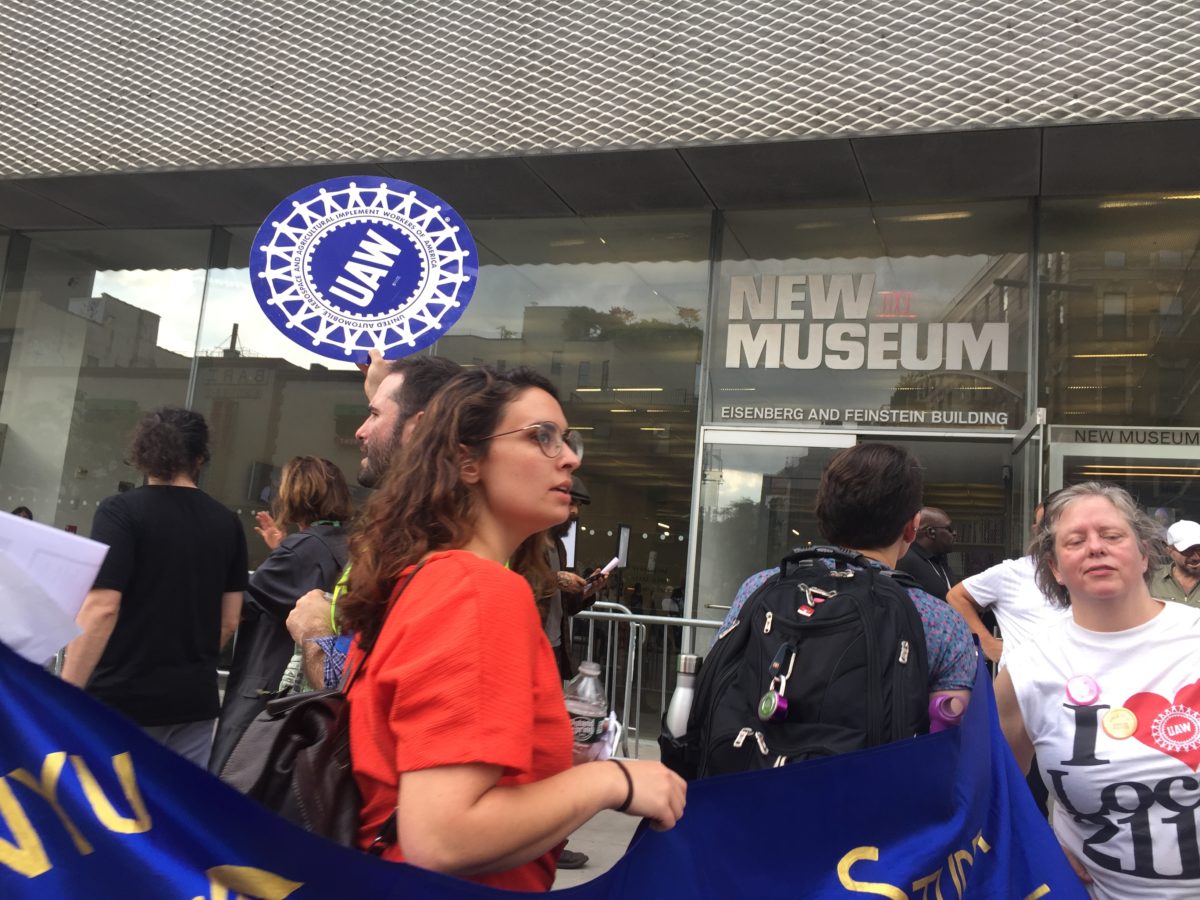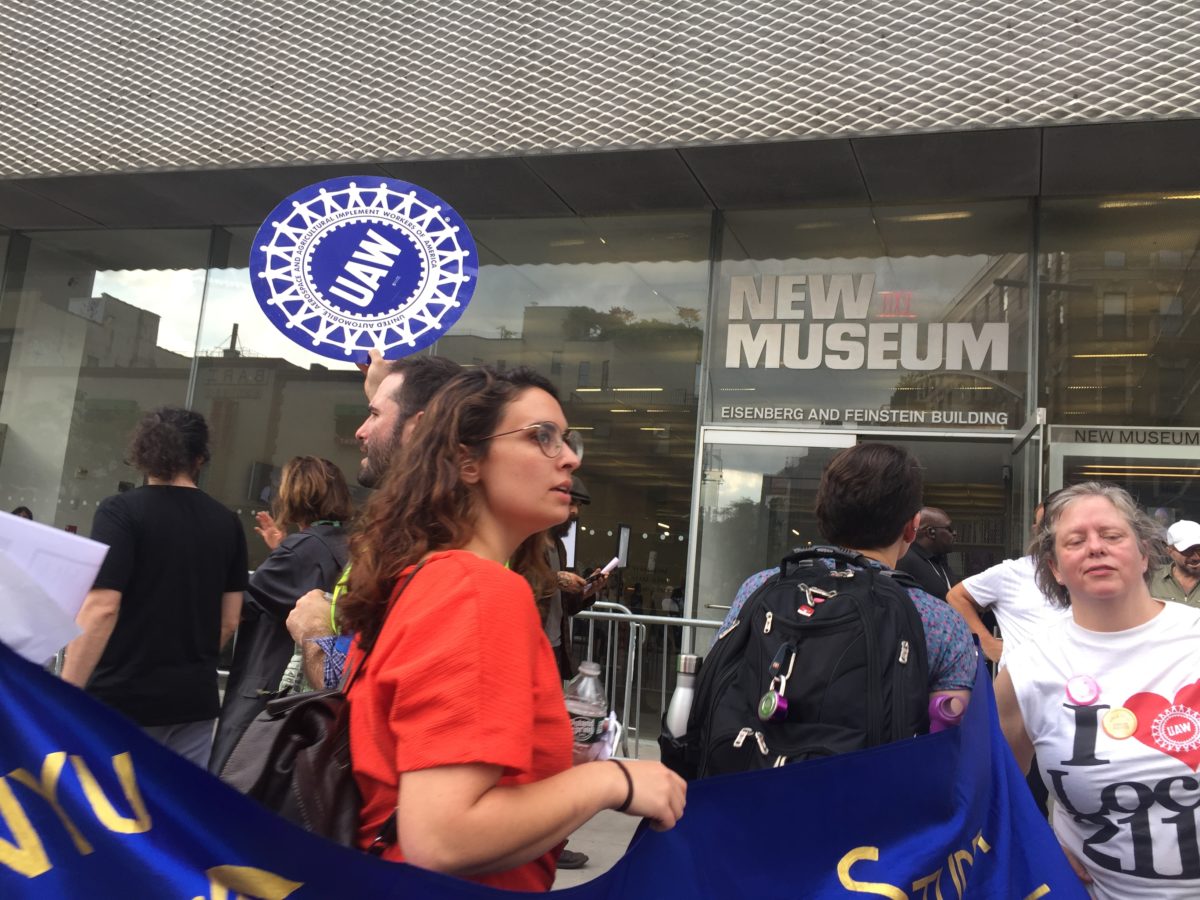[ad_1]

The New Museum Union staging an action at the New Museum in New York on June 25, 2019.
ALEX GREENBERGER/ARTNEWS
After months of bargaining, a protest, and a vote to authorize a strike, the New Museum Union and the New York institution have agreed on a contract.
The contract, which is active as of this past Tuesday and continues through June 30, 2024, offers union members a new wage structure and ensures that there will be new workplace safety measures in place at the museum. It is the result of seven months of negotiations with members of the union, which was formed in January.
“This is really going to change things for the better,” Dana Kopel, a senior editor and publications coordinator at the museum, told ARTnews.
Among the union’s demands had been a minimum annual wage of $51,000 for full-time employees at the institution—something that is not in the contract struck with the museum. “We had to compromise on wages,” Kopel said. The contract does, however, include a new wage structure that is tiered according to four grades, through which full-time employees receive minimum annual wages of between $46,000 to $68,500 a year. Regular part-time employees will receive between $20.50 and $22.50 per hour by the end of the contract’s run.
Also in the contract are reduced employee health care contributions, increased time off, and a measure that will require the museum to rely on art handlers and registrars who already have relationships with the institution instead of outside contractors when possible. There are also what Kopel called “less glamorous aspects” to the agreement, such as new measures that will allow the union to meet on the New Museum’s grounds.
“The New Museum has invested in our staff and will continue to do so to promote a diverse and thriving culture,” a spokesperson for the New Museum said in a statement. “We look forward to continuing to work together to advance the museum’s important mission.”
Last week, the union’s 70-plus members voted almost unanimously to authorize a strike. Kopel said at the time that the vote was intended as “a way of putting pressure on the museum,” whose leadership had previously been “hostile” to the union’s demands. (The museum rebutted that claim, saying in a statement that it had made “considerable progress” toward a contract.)
The New Museum Union, which is part of the UAW Local 2112 union, was formed in January, and has since become one of the most closely watched groups of its kind in New York art institutions. In the run-up to its formation, the museum had employed the Kentucky-based consulting firm Adams Nash Haskell & Sheridan, which the union had alleged was waging “a harsh union-busting campaign.” After an open letter signed by artists Hannah Black, Andrea Fraser, and others was printed by Artforum, the museum said it was no longer working with the firm.
In June, amid negotiations, the New Museum Union led an action during an opening reception for exhibitions by Lubaina Himid, Mika Rottenberg, and others. Roughly 50 workers at the museum assembled in an attempt to bring light to the ongoing talks.
The contract agreement marks a major milestone for the new union, which is one of many workers’ groups that have been formed recently. Unions have been formed over the past couple years at the Guggenheim Museum, the Brooklyn Academy of Music, and the art storage company Uovo, all of them in New York, as well as at the Frye Art Museum in Seattle.
At institutions with existing unions, workers have also been successful in pushing for new contracts that have included raises and improved working conditions. At the Museum of Modern Art in New York last year, members of the union Local 2110 UAW secured a higher raise structure for workers, and at that institution’s sister museum, MoMA PS1 in Queens, a separate workers’ group established a new agreement that likewise altered their system for receiving raises and extended their working hours. Meanwhile, at the Metropolitan Museum of Art in New York, licensed HVAC assistant maintenance workers received a 63 percent raise following a year of negotiations.
The advocacy by these workers’ groups comes amid broader calls for transparency in art-world workplaces—a trend exemplified by a circulating Google Spreadsheet earlier this year by the group Art + Museum Transparency in which museum workers were encouraged to disclose their salaries. That group has since called on prospective workers to stop taking unpaid internships.
Speaking of the union’s efforts, Kopel said, “This isn’t a one-off,” and added, “It’s really amazing that workers in the art world and the cultural sector are coming together to make changes, to make it a more equitable workplace. That obviously means better benefits, but it also means have a voice in the place you work.”
[ad_2]
Source link

